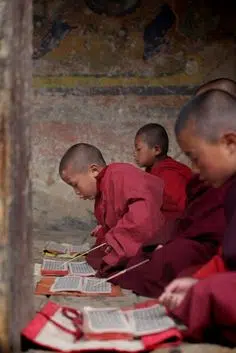
Would you rather be read to?
India in the 6th Century BCE suffered: wars, economic uncertainty… sound familiar? On an unapproved outing, Prince Siddhartha left his father’s palace and encountered sickness, old age and death. Extremely sheltered, he was unaware of these existential challenges. But he also met a renunciant, at peace in the misery. Siddhartha became a monk and after years practice, while meditating under a Bodhi tree in Bodhgaya, India, became a Buddha (“awakened one”). Then he walked to Deer Park in Benares (Varanasi) to explain the path of liberation.
His journey to find his spiritual-friends was arduous – a 6-hour bus ride for me on a recent visit. They continued the same strict asceticism that Siddhartha had previously practiced. When he broke his near-starvation diet with milk and rice pudding upon the realization that asceticism was not working, they were disillusioned with him. But when they saw the enlightened Buddha they sensed he had changed and willingly received his talk on his discoveries.
The Four True Realities for the Noble Ones, the essence of Buddhist psychology, are a powerful framework to investigate ourselves. In Pali they are: dukkha, samudaya, nirodha and magga identifying the life’s unsatisfactoriness, its cause, its absence and a path to that state (the Eightfold Path).
Dukkha
Even pleasant experiences are unsatisfactory due to impermanence, therefore incapable of satisfying us.
Dissatisfaction and anxiety are prevalent, especially in comfortable, affluent societies, with freedom to choose one’s lifestyle, spouse, beliefs (if any) and opportunities to study and expand the mind. I grew up without any of these – like most people on this planet.
Survival is instinctual. I watch squirrels grab a seed from the feeder and escape to a nearby tree. I watch a bird chase an insect but one miscalculated jump…lands it in the bird’s beak. We are easily hurt physically and emotionally, leading to fear and could always live expecting something. I like “enlightenment” defined as awakening to the realities of existence.
Studying the Four Noble Truths – I took a stark look at myself. This week should have been very exciting as I was invited to be an IMCW affiliate-teacher, years of work in the making. But as congratulatory emails still arrived, I was thinking…What’s next? When will my name be on the website? Which photo works best? This is dukkha. I tend to look for what’s next, keeping me from noticing what I have, perpetuating unsatisfactoriness.
Thinking, “I am an ungrateful, greedy, angry person… how do I stop this feeling?”, is unskilful and triggers self-judgement. Instead, contemplating these conditions as impermanent moments of ungratefulness, greed or irritation, an honest reflection of the way things are, not equating these faults to you, is skillful.
My life is great, but frequently I am irritated by my children’s tone or chores not getting done. Even when life great, there is a sense of lacking. I love Reston’s trees – I anguish when they are cut down – I want a continual flow of beautiful sights… the small stream with swimming ducks. I want to consume everything with my eyes. That is dukkha. (ducka)
To escape this, change “I am suffering.” to, “There is the presence of suffering.” We needn’t identify ourselves with the problem but simply acknowledge there is one. These teachings help us to address everyday challenges with care, love and steadiness and prepare us for the biggest challenges.
In truth: these 10,000 joys and 10,000 sorrows are universal. I like this reading:
“Your suffering is my suffering, my suffering is your suffering. Their suffering is our suffering. Your welfare is my welfare. My welfare is your welfare. Their welfare is our welfare. Our welfare is your welfare. Lets care for the welfare of all.”
